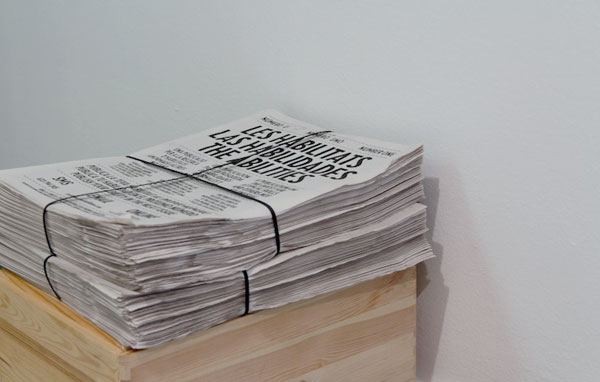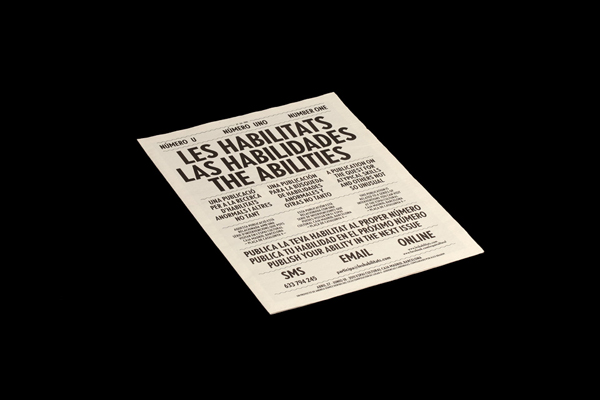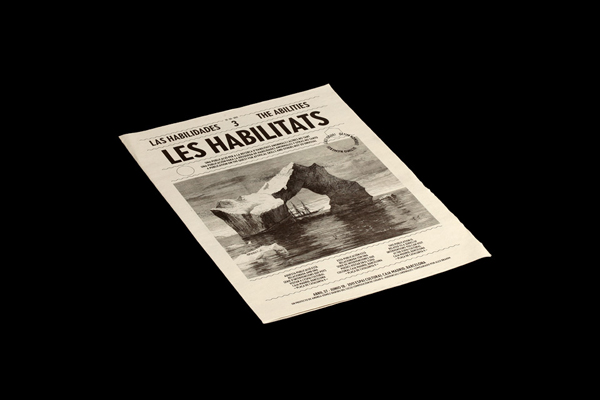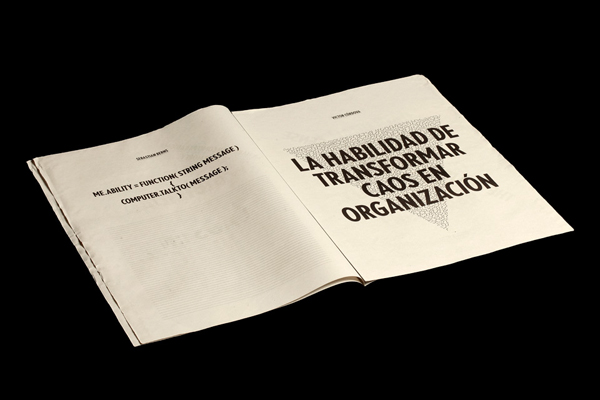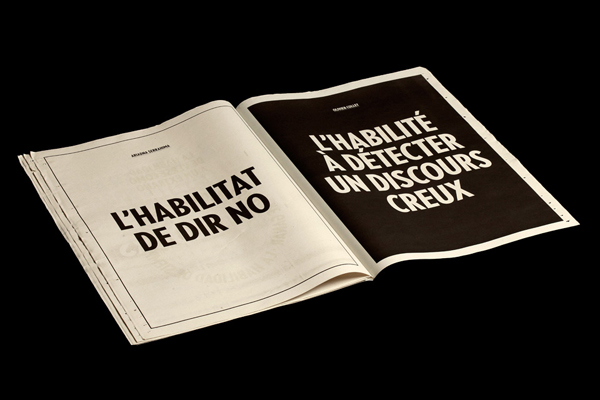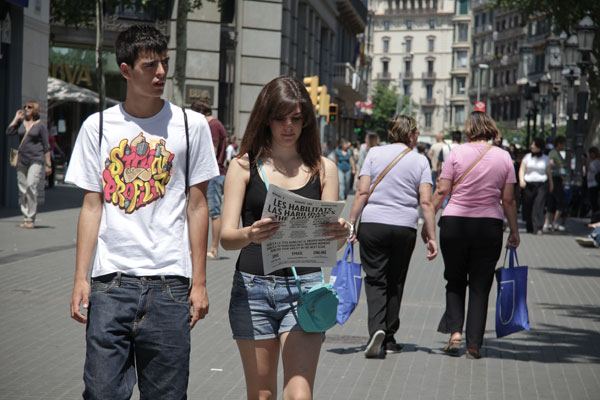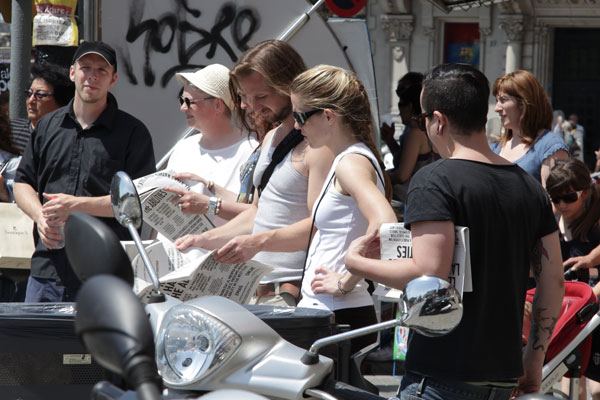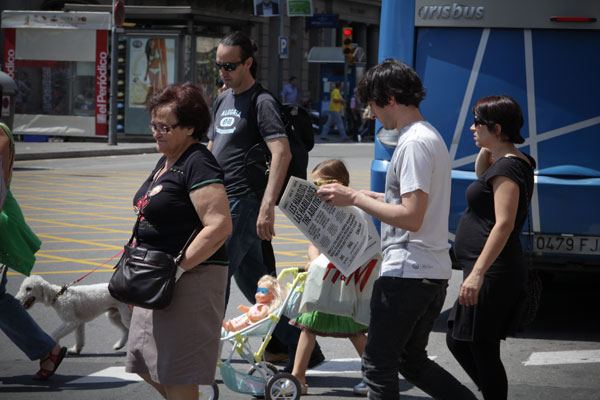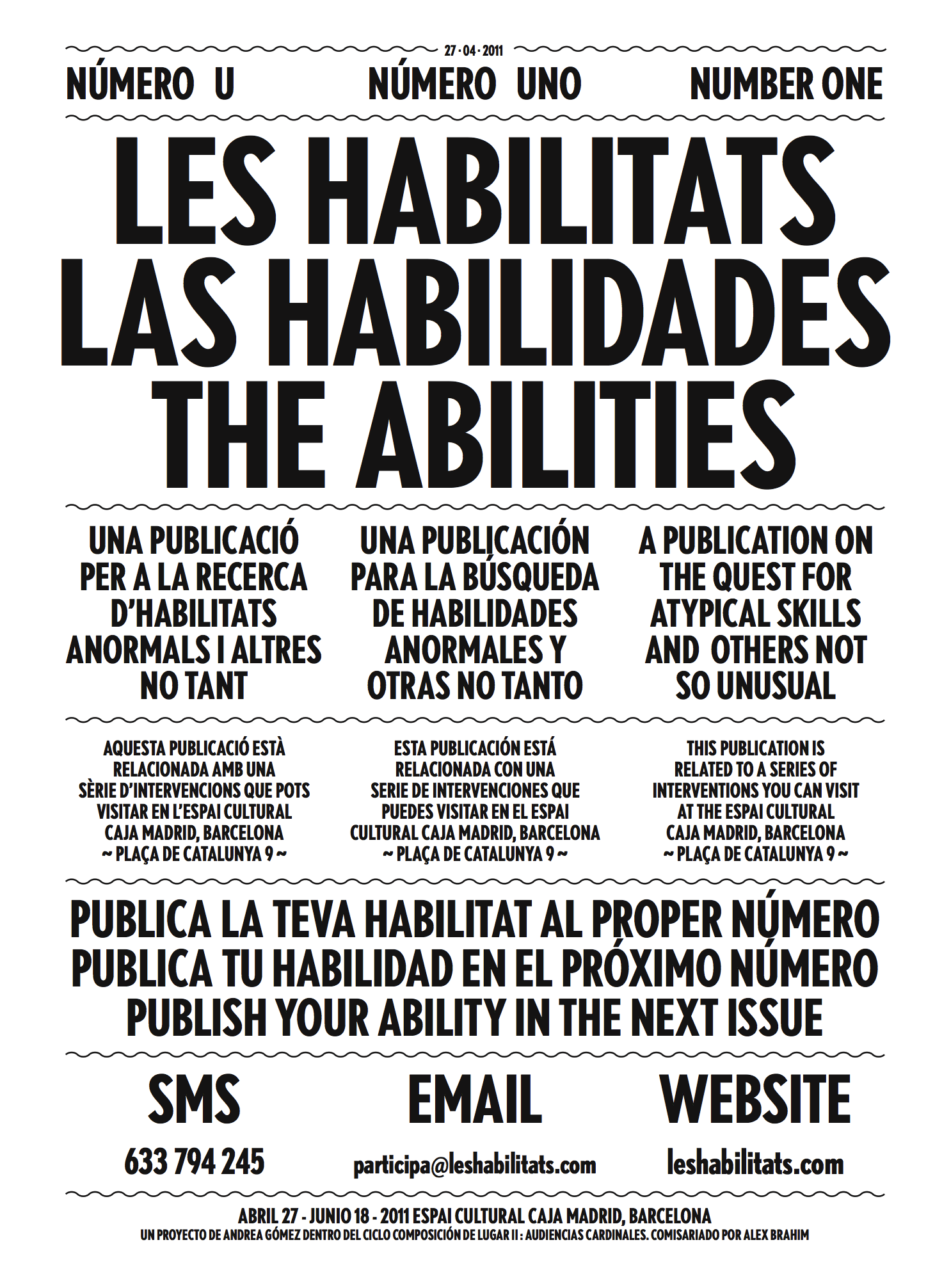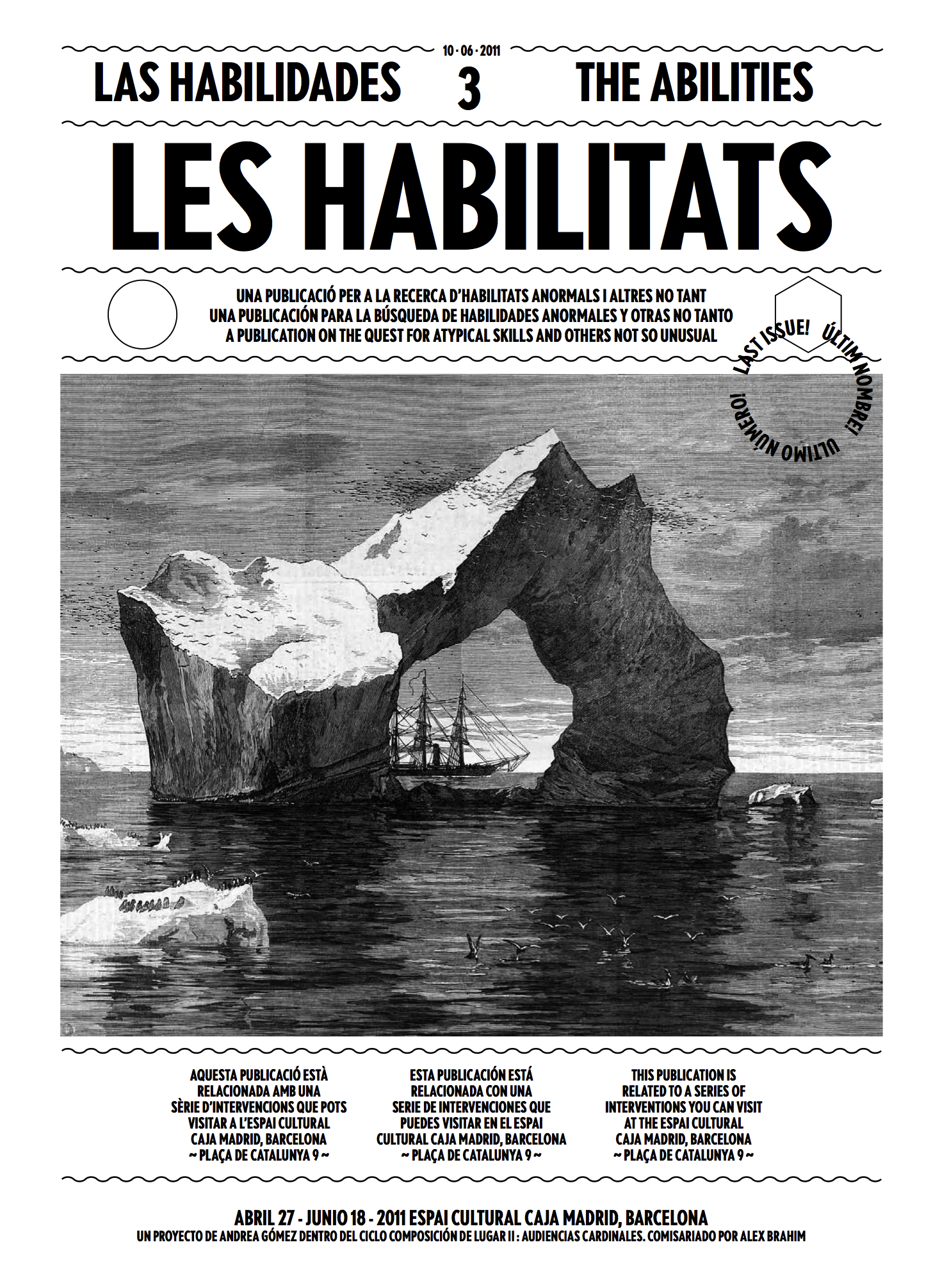
Les Habilitats
2011
Publication, site specific.
Curated by Alex Brahim
Design Cordova Canillas
CCCM Barcelona
︎
See Publications
#1
#2
#3
2011
Publication, site specific.
Curated by Alex Brahim
Design Cordova Canillas
CCCM Barcelona
︎
See Publications
#1
#2
#3
︎︎︎Eng
«The single biggest problem in communication is the illusion that is taking place.»
George Bernard Shaw
In the course of a year, four solo projects by Barcelona-based artists take shape in the spaces outside the exhibition rooms, superimposed onto the architecture of the venue like a transitory layer of meaning. These coordinates set the scene for Cardinal Audiences to take over from “Composition of Place” curated by Manuel Segade, which was the first of this programme of exhibitions launched by Espai Cultural Caja Madrid (CCCM) in 2010.
«The single biggest problem in communication is the illusion that is taking place.»
George Bernard Shaw
In the course of a year, four solo projects by Barcelona-based artists take shape in the spaces outside the exhibition rooms, superimposed onto the architecture of the venue like a transitory layer of meaning. These coordinates set the scene for Cardinal Audiences to take over from “Composition of Place” curated by Manuel Segade, which was the first of this programme of exhibitions launched by Espai Cultural Caja Madrid (CCCM) in 2010.
︎︎︎Eng
«The voices of the narrative come, go, disappear, overlap; we do not know who is speaking; the text speaks, that is all: there is no more image, nothing but language. But the other is not a text, the other is an image, single and coalescent; if the voice is lost, it is the entire image which vanishes (love is maniacal, monological, the text is heterologi- cal, perverse).»
Roland Barthes, “A Lover’s Dis- course: Fragments”
«The ability to change the meaning of an image.» This statement does not match the conventional dictionary de nition. An ability is an individual’s level of skill in relation to a speci c objective, using all of his or her dexterity and competence to negotiate and achieve something. In short, an ability is considered to be an innate or learned aptitude – or several aptitudes –, while the level of improve- ment attained by means of practising said ability is known as ‘talent’. In this project, the artist’s talent is reduced to re ecting on words, on language and its relationship to artistic practices. Somewhat like an escape valve within the entrenched endogamy of the art world, it is a descriptive demonstra- tion of the impossibility of naming an action, an artwork or a creative act, in their entirety, by means of language. The overall project nds its meaning in transitory experience. The implemen- tation of an artwork through language, through interlocution, through the ‘pro- sumer’. «The ability to nd unexpected help.»
“Les habilitats” requires spec- tators who are producers, committed dilettantes. The roles of transmitter and receiver are distorted. The purpose is thus limited to achieving some level of dynamic communication. As such, all the channels of the work expand, and the artist’s role becomes blurred. The weight of the creative act is relegated to an initial action. An original manoeu- ver, a ‘modus operandi’ that becomes a pattern, an outline or a diagram, and demands a scope of in uence in re- gards to the scene of ‘the real’.
A necrophilic digression: “Ceci n’est pas une pipe” [This is Not a Pipe] – René Magritte ( rst version, 1926) and Michel Foucault’s homonymous essay on Magritte (1973). Foucault takes the opportunity to develop his theories on the frail illusion that con- nects words and things. He states that all creative phases are organised around the category of things and the category of words, and that there must be a division between the two in order for the world to be intelligible based on the endless, parallel, simultaneous line of action and the narrative itself. «The ability to give the world a double and a triple meaning.»
«The ability to turn anything into a stone.» To position oneself in the interlude between reality and action, between plausibility and improbability, between true competence and de- posited faith (in something or some- body). This positioning appropriates the role of the artist and her scope of action – in other words, her competen- cies. It is highly (or totally) improbable that anybody would be able to turn a real thing into a real stone. And here, at this precise instant, is where the point from which the discourse of the artist emerges. Without any doubt, many of the abilities that she refers to belong to a kind of symbolic ction. Perhaps that is the point at which to – accidentally – venture the role of the artist-shaman, as though we were dealing with an alchemical ritual. «The ability to make rain.»
«The ability to create sparks from con ict.» The unfeasible, the im- possible and the fantastic contrast with the skill with which the action is carried out, and with the willingness to ne- gotiate and attain objectives through actions involving people – individually or in groups. The tautology “the ability of/to...” is synonymous with metalan- guage. To go beyond art and posi- tion oneself in a harmonious space of denunciation. As a result, the artist issues a challenge: to insert ourselves into certain mechanisms of language sophistication. «The ability to leave the comfort zone.»
In an exercise in minimising, reducing and almost fossilising “Les habilitats”, an essential, unique and irreplaceable element appears: the word. In its essence, it is what allows the project to take place. «The ability to make the word triumph over the revolution.» To revolutionise the word, the revolution in the word, to ‘work’ the word in a revolutionary sense. Without words there is no capacity or aptitude for speaking or expression, there is no possibility of transmitting a message; without messages there can be no information, there is no communica- tion; without communication all inter- locution becomes void, there is no dialogue. Without dialogue the artwork denies itself, becomes a ‘dialogue of the deaf’ – a conversation in which nei- ther party seems to listen to the other. «The ability to nd the source.»
«The ability to admit you don’t know anything and therefore begin to learn more.» Are we then talking about social skills? If we bear in mind that so- cial skills are all verbal and non-verbal ways of acting or behaving that favour interpersonal relations, then a prudent interaction between the spectator in the work (and the work in the specta- tor) strategically emerges. This situa- tion makes it necessary to turn back to the roots of the project. To scrupu- lously rethink its boundaries, its scope, its actual necessity.
“Les habilitats” is anchored in a textual clause. The work is assembled from the mediating text. Audience par- ticipation provides the content. Once again, (re)construction according to the rules of the artist: a new order of language. To perpetuate the ‘raison d’être’ of “Les habilitats” in the power of the word (and in stopping and perhaps even freezing it): «The ability to simu- late eclipses.»
— Joan Morey
«The voices of the narrative come, go, disappear, overlap; we do not know who is speaking; the text speaks, that is all: there is no more image, nothing but language. But the other is not a text, the other is an image, single and coalescent; if the voice is lost, it is the entire image which vanishes (love is maniacal, monological, the text is heterologi- cal, perverse).»
Roland Barthes, “A Lover’s Dis- course: Fragments”
«The ability to change the meaning of an image.» This statement does not match the conventional dictionary de nition. An ability is an individual’s level of skill in relation to a speci c objective, using all of his or her dexterity and competence to negotiate and achieve something. In short, an ability is considered to be an innate or learned aptitude – or several aptitudes –, while the level of improve- ment attained by means of practising said ability is known as ‘talent’. In this project, the artist’s talent is reduced to re ecting on words, on language and its relationship to artistic practices. Somewhat like an escape valve within the entrenched endogamy of the art world, it is a descriptive demonstra- tion of the impossibility of naming an action, an artwork or a creative act, in their entirety, by means of language. The overall project nds its meaning in transitory experience. The implemen- tation of an artwork through language, through interlocution, through the ‘pro- sumer’. «The ability to nd unexpected help.»
“Les habilitats” requires spec- tators who are producers, committed dilettantes. The roles of transmitter and receiver are distorted. The purpose is thus limited to achieving some level of dynamic communication. As such, all the channels of the work expand, and the artist’s role becomes blurred. The weight of the creative act is relegated to an initial action. An original manoeu- ver, a ‘modus operandi’ that becomes a pattern, an outline or a diagram, and demands a scope of in uence in re- gards to the scene of ‘the real’.
A necrophilic digression: “Ceci n’est pas une pipe” [This is Not a Pipe] – René Magritte ( rst version, 1926) and Michel Foucault’s homonymous essay on Magritte (1973). Foucault takes the opportunity to develop his theories on the frail illusion that con- nects words and things. He states that all creative phases are organised around the category of things and the category of words, and that there must be a division between the two in order for the world to be intelligible based on the endless, parallel, simultaneous line of action and the narrative itself. «The ability to give the world a double and a triple meaning.»
«The ability to turn anything into a stone.» To position oneself in the interlude between reality and action, between plausibility and improbability, between true competence and de- posited faith (in something or some- body). This positioning appropriates the role of the artist and her scope of action – in other words, her competen- cies. It is highly (or totally) improbable that anybody would be able to turn a real thing into a real stone. And here, at this precise instant, is where the point from which the discourse of the artist emerges. Without any doubt, many of the abilities that she refers to belong to a kind of symbolic ction. Perhaps that is the point at which to – accidentally – venture the role of the artist-shaman, as though we were dealing with an alchemical ritual. «The ability to make rain.»
«The ability to create sparks from con ict.» The unfeasible, the im- possible and the fantastic contrast with the skill with which the action is carried out, and with the willingness to ne- gotiate and attain objectives through actions involving people – individually or in groups. The tautology “the ability of/to...” is synonymous with metalan- guage. To go beyond art and posi- tion oneself in a harmonious space of denunciation. As a result, the artist issues a challenge: to insert ourselves into certain mechanisms of language sophistication. «The ability to leave the comfort zone.»
In an exercise in minimising, reducing and almost fossilising “Les habilitats”, an essential, unique and irreplaceable element appears: the word. In its essence, it is what allows the project to take place. «The ability to make the word triumph over the revolution.» To revolutionise the word, the revolution in the word, to ‘work’ the word in a revolutionary sense. Without words there is no capacity or aptitude for speaking or expression, there is no possibility of transmitting a message; without messages there can be no information, there is no communica- tion; without communication all inter- locution becomes void, there is no dialogue. Without dialogue the artwork denies itself, becomes a ‘dialogue of the deaf’ – a conversation in which nei- ther party seems to listen to the other. «The ability to nd the source.»
«The ability to admit you don’t know anything and therefore begin to learn more.» Are we then talking about social skills? If we bear in mind that so- cial skills are all verbal and non-verbal ways of acting or behaving that favour interpersonal relations, then a prudent interaction between the spectator in the work (and the work in the specta- tor) strategically emerges. This situa- tion makes it necessary to turn back to the roots of the project. To scrupu- lously rethink its boundaries, its scope, its actual necessity.
“Les habilitats” is anchored in a textual clause. The work is assembled from the mediating text. Audience par- ticipation provides the content. Once again, (re)construction according to the rules of the artist: a new order of language. To perpetuate the ‘raison d’être’ of “Les habilitats” in the power of the word (and in stopping and perhaps even freezing it): «The ability to simu- late eclipses.»
— Joan Morey
